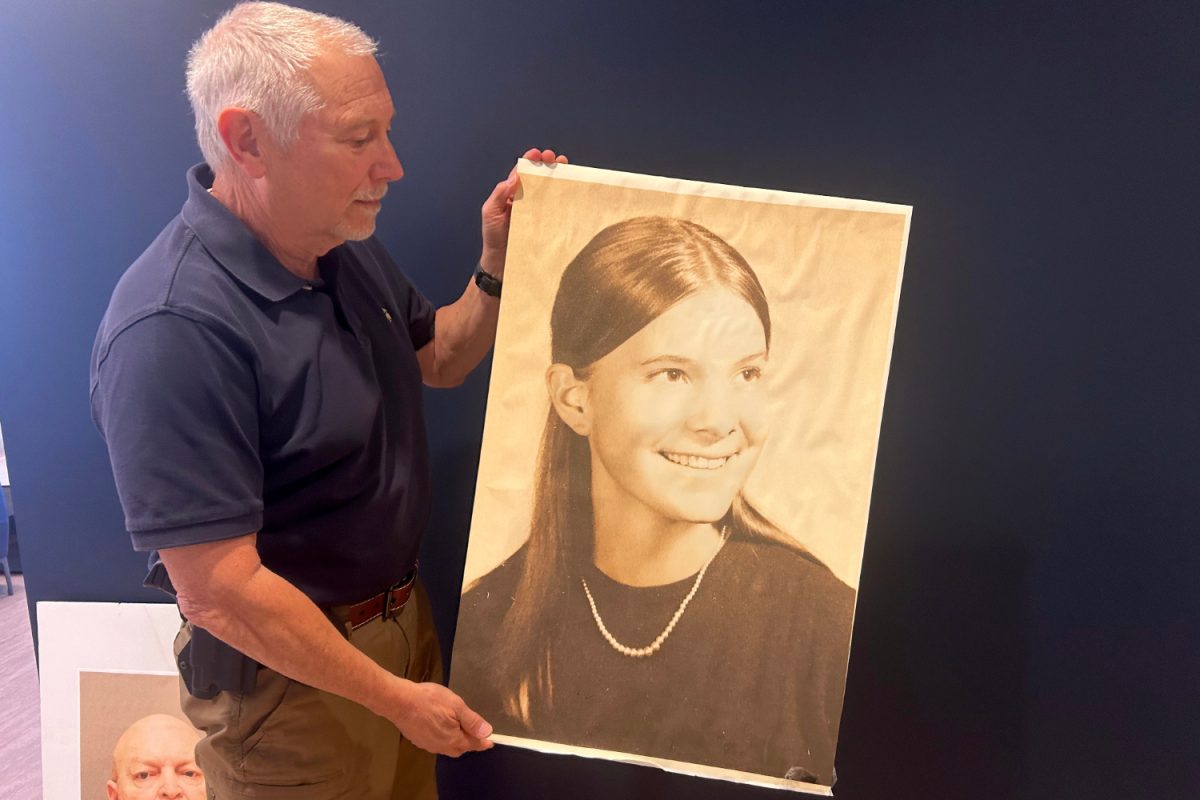After more than 45 years, justice was served to Janet Taylor, whose murder had been solved due to the evolution of technology and the determination of two cold case detectives.
Taylor was a 19-year-old Stanford University student and recent Menlo-Atherton High School graduate when she was strangled to death in 1974. A passing driver found her body on Sand Hill Road west of Interstate 280.
When all the leads dried up, the file was put on the shelf, not to be touched again for 45 years.
This is not unusual.
More than 316,000 Americans have perished in unsolved homicides committed since 1970, according to the Murder Accountability Project, which tracks unsolved homicides.
There are over 200 unsolved cases within San Mateo County, according to David Tresmontan, a detective for San Mateo County.
Cold to Hot
In 2019, the Taylor case was “cherrypicked” by a sergeant and landed on the desks of Tresmontan and Rick Jackson, cold case detectives for the San Mateo County Sheriff’s Office.
Tresmontan and Jackson have been working in law enforcement since the 1970s. They had both retired from being detectives but then came back, eventually finding their own paths to the San Mateo County Sheriff’s Office specifically to work on cold cases. They became partners in 2017.
“The unsolved murders haunt you more than the solved. Murders are terrible. They’re haunting and everything else, but the ones that you can’t get answers for the family, that’s the tough part,” Jackson said.
The Cold Facts
Tresmontan and Jackson learned that in March 1974, Taylor was hitchhiking to her home in La Honda from a friend’s house in Palo Alto. Her body was found the following day.
The detectives discovered there was a similar case in Santa Clara County involving Leslie Perlov, a 21-year-old, whose body was found in 1973. Her body was found within two miles of Taylor’s near the Stanford campus.
“The investigators, even back then in the ‘70s, thought they were linked and could have been done by the same person. They didn’t know who, but they always thought that it could have been the same suspect,” said Josh Stauffer, an assistant district attorney in San Mateo County.
When Tresmontan and Jackson picked up the case in 2019, they worked with Santa Clara County investigators to try to connect the two brutal homicides.
Perlov was found with DNA underneath her fingernails, which could have been helpful, but they didn’t have her killer’s DNA in their law enforcement databases. The investigators then went a different route of genealogy. They found someone with similar DNA and looked into the family tree, leading them to John Getreu.
John Getreu had a previous rape charge which led investigators to look into him more closely. They obtained a coffee cup he had discarded to take his DNA from and found a match.
“They got a search warrant to get his DNA to confirm it was, in fact, him, and they linked his DNA,” Stauffer said.
Rare to Solve
At this point, Perlov’s case had a match, but Taylor’s did not. Taylor’s detectives then sent Taylor’s pants to the lab to be tested. While there, they found a rip in the crotch area. The forensics team got the DNA from the area and amplified it.
“They got it up to a level where there was enough to compare, and it matched Getreu. I mean, their numbers were astronomical similar,” Jackson said.
Even though, in Taylor’s case, the forensic team was able to match the DNA, this process is a lot more difficult in many cases. Many of the challenges include the lab being backed up, DNA not even being found, or the low priority of cold cases.
“I know on TV, they get the DNA, and everything is solved within 60 minutes. In reality, it could take up to a year sometimes to get the results back. They could do it faster if they had more help, but they don’t, and there’s an overwhelming amount of DNA requests from all the agencies, so cold cases are not a priority. We tend to be at the back of the line all the time,” Tresmontan said.
Justice Served
With new matches in both cases, Santa Clara County investigators asked San Mateo County to prosecute Getreu first because they believed San Mateo County had a stronger case.
“It took the jury less than an hour to convict after three weeks of testimony, three weeks and less than an hour, which is pretty amazing. And so, ultimately, he was sentenced,” Tresmontan said.
Getreu was convicted of 1st-degree murder, according to the San Mateo County District Attorney’s Office. Two years later, he received a second life sentence after pleading guilty to murdering Perlov. He died in September 2023 while in prison.
While in Perlov and Taylor’s cases, the evidence was all there, and a successful outcome came from the efforts of detectives, this is rarely the case.
“Cold cases like that are relatively rare because, in reality, with a case that old, it really relies on some sort of DNA. So unless you have that kind of evidence, it’s often not going to be a case that’s going to be provable,” Stauffer said.
When cases go cold, there are the obvious consequences of a person getting away with a crime, but there are psychological consequences as well.
“I tried not to go visit the victim’s family until I knew there was something unless I needed to pick their brain about something. When you go back to those people, the minute you approach them and tell them why you’re there, it generally takes them right back. People break down because it’s been built up and put in a different portion of the brain just so they can keep moving, but it takes them right back,” Jackson said.
Through new technology and different techniques, more and more cold cases are being solved. That allows families closure and the peace of mind of knowing what happened to their loved ones.
“If it happened today, with all the advances in technology, we would have identified the DNA profile very quickly. The issue would have been figuring out who that profile belonged to, and they probably would have done the same thing we did, which is they would have used genealogy to see if they could identify a family tree and then try to find the suspect. That way, I think that it would have been solved rather quickly nowadays, given our technology,” Stauffer said.
Despite the number of advances, the number of unsolved homicides increases by 6,000 each year, according to the U.S. Department of Justice.
Technology Advances
Over the years, technology has evolved to help detectives solve crimes with smaller sample sizes of blood or DNA, advances in DNA reading, and cyber sleuthing.
“Computer technology allows us to share things rather quickly. It allows us to compare things quickly as AI is now in law enforcement,” Tresmontan said.
One of the chief uses of AI, or artificial intelligence, is to find similarities or inconsistencies between cases. This is a task that could take a human detective weeks or months, while AI can do it in a matter of hours.
Along with advances in the cyber world, DNA testing has also improved. Forensic teams are now able to use smaller amounts of DNA to figure out even more information than ever before. Scientists need just one nanogram – one billion times less than one gram – of DNA to get a match, according to the United States Government Accountability Office.
“But most cases are not solved by DNA,” Tresmontan said. “You need witnesses, cell phones, fingerprints, cameras. I mean, DNA is a wonderful tool, but it’s not available in all cases.”
Fingerprint and facial recognition technologies have helped solve crimes for years, but with more cameras and better enhancement technology, they are having a deeper impact on investigations, according to the United States Department of Justice.
“In the old days, if you had a fingerprint, you had to manually compare it. Now you can run the database through national and international databases, and in just the FBI database, we have 7 million people,” Jackson said.
Solving these types of cases still takes countless hours of determination from many different departments, but it is all worth it in the end when justice is served.
“They’re unique cases because they sort of tuck at your heartstrings because justice has been denied for so long for these people. And it’s just such a joyous moment when you actually bring closure to families who’ve been suffering for, in this case, decades. So it’s, really, probably one of the most rewarding aspects of working in this type of a field,” Stauffer said.























